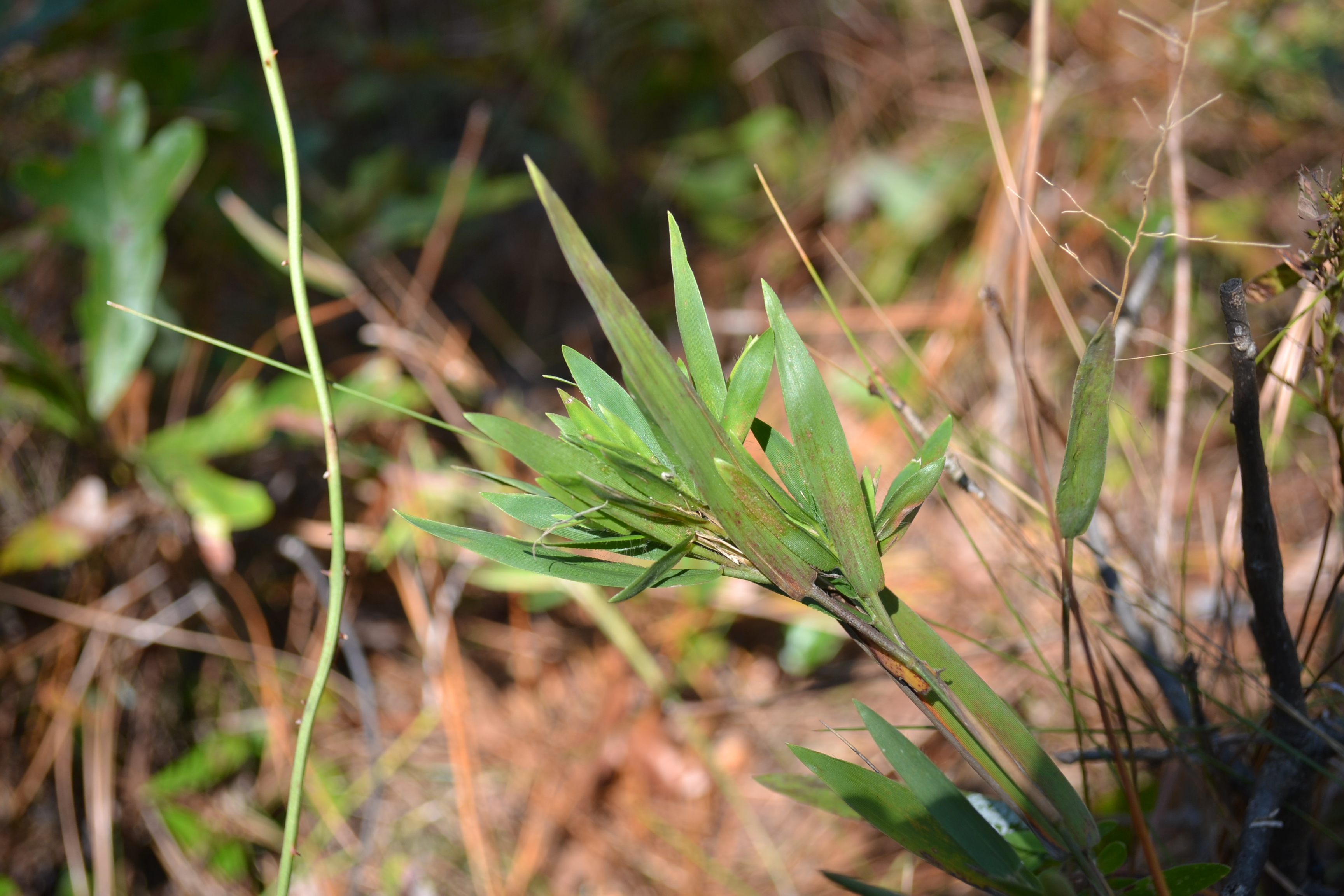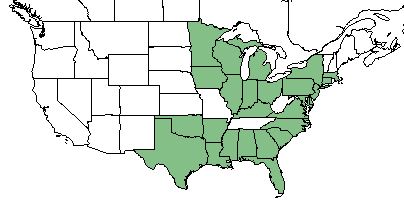Difference between revisions of "Dichanthelium ovale"
Emmazeitler (talk | contribs) (→Taxonomic Notes) |
(→Description) |
||
| Line 27: | Line 27: | ||
==Description== | ==Description== | ||
<!-- Basic life history facts such as annual/perrenial, monoecious/dioecious, root morphology, seed type, etc. --> | <!-- Basic life history facts such as annual/perrenial, monoecious/dioecious, root morphology, seed type, etc. --> | ||
| − | Also known as eggleaf rosette grass, '' | + | Also known as eggleaf rosette grass, ''Dichanthelium ovale'' is a native perennial graminoid that is a member of the Poaceae family. It has a rapid growth rate reaching a mature height of 1.7 meters on average, and a short lifespan. <ref name= "USDA"> USDA Plants Database URL: https://plants.usda.gov/java/charProfile?symbol=DIOV </ref> It is distinguished from ''D. consanguineum'' by the upper blade surface being glabrous with few short basal hairs while ''D. consanguineum'' has strongly pilose upper surfaces on the leaf blade.<ref name= "Weakley"/> |
| + | |||
| + | ''D. ovale'' does not have specialized underground storage units apart from its fibrous roots.<ref name="Diaz"> Diaz-Toribio, M.H. and F. E. Putz 2021. Underground carbohydrate stores and storage organs in fire-maintained longleaf pine savannas in Florida, USA. American Journal of Botany 108: 432-442.</ref> Diaz-Toribio and Putz (2021) recorded this species to have a water content of 54.1% (ranking 69 out of 100 species studied).<ref name="Diaz"/> | ||
==Distribution== | ==Distribution== | ||
Revision as of 19:24, 11 May 2021
oval-flowered witchgrass; low stiff witchgrass
| Dichanthelium ovale | |
|---|---|

| |
| Photo by Kevin Robertson | |
| Scientific classification | |
| Kingdom: | Plantae |
| Division: | Magnoliophyta - Flowering plants |
| Class: | Liliopsida - Moncots |
| Order: | Poales |
| Family: | Poaceae |
| Genus: | Dichanthelium |
| Species: | D. ovale |
| Binomial name | |
| Dichanthelium ovale (Elliot) Gould & C.A. | |

| |
| Natural range of Dichanthelium ovale from USDA NRCS Plants Database. | |
Contents
Taxonomic Notes
Synonyms: Dichanthelium ovale ssp. ovale; D. ovale ssp. pseudopubescens (Nash) Freckmann & Lelong; D. commonsianum (Ashe) Freckmann; Panicum addisonii Nash; P. commonsianum Ashe; P. commonsianum var. commonsianum; P. commonsianum var. addisonii (Nash) Fernald; P. malacon Nash; P. mundum; P. ovale Elliott; P. ovale var. ovale; P. ovale Elliott var. pseudopubescens (Nash) Lelong; P. wilmingtonense Ashe.[1]
Varieties: Dichanthelium ovale (Elliott) Gould & Clark var. addisonii (Nash) Gould & Clark; Dichanthelium ovale (Elliott) Gould & Clark var. ovale.[1]
Description
Also known as eggleaf rosette grass, Dichanthelium ovale is a native perennial graminoid that is a member of the Poaceae family. It has a rapid growth rate reaching a mature height of 1.7 meters on average, and a short lifespan. [2] It is distinguished from D. consanguineum by the upper blade surface being glabrous with few short basal hairs while D. consanguineum has strongly pilose upper surfaces on the leaf blade.[3]
D. ovale does not have specialized underground storage units apart from its fibrous roots.[4] Diaz-Toribio and Putz (2021) recorded this species to have a water content of 54.1% (ranking 69 out of 100 species studied).[4]
Distribution
D. ovale grows in the eastern United States, ranging from east Texas up to New York and Michigan, excluding West Virginia, Tennessee, and Missouri.[2] D. ovale var. ovale is distributed from New York to Wisconsin as well as south Florida and west to eastern Texas. D. ovale var. addisonii can be found from Massachusetts and Minnesota south to Florida and Texas, and is also native to northern Mexico.[3]
Ecology
Habitat
D. ovale var. addisonii grows in a range of dry to damp soils and in sandy woods and fields, while D. ovale var. ovale grows in damp to dry and sandy pinelands.[3] More specifically, D. ovale has been observed in a range of habitats including open limestone glades, moist soil, longleaf pineland bogs, moist sandy peat, coarse sand habitats, abandoned fields, sandhills, and other sandy loams. [5] It has been seen to be more abundant in disturbed areas. [6] It is listed as a facultative upland species, where it is mostly found in upland non-wetland habitats but can occasionally be found in wetlands as well.[2] It prefers partial shade and low amount of water use.[7] In Florida, D. ovale is abundant in the xeric sandhills of the peninsula and the panhandle.[8]
Associated species: Aristida beyrichiana, Sorghastrum secundum, and Schizachyrium scoparium var. stoloniferum.[8]
Dichanthelium ovale var. addisonli is frequent and abundant in the Peninsula Xeric Sandhills, Panhandle Xeric Sandhills, North Florida Longleaf Woodlands, North Florida Subxeric Sandhills, and Clayhill Longleaf Woodlands community types as described in Carr et al. (2010).[9]
Phenology
The species flowers in the springtime beginning in May, and continues to develop fruit throughout October.[3] Fruit has been seen in the months March through June and August. [5]
Seed dispersal
This species is thought to be dispersed by gravity. [10]
Seed bank and germination
A study found seeds of D. ovale to persist in the seed bank on a restoration project even when herbaceous cover of the species was not found. It was found to germinate at the restoration site with high frequency.[11]
Fire ecology
D. ovale is mostly found in fire dependent pinelands in sandhill communities.[8] This was also seen by a fire exclusion study, where this species disappeared when fire regiments were ceased.[12]
Pollination
Like other grasses, flowers of the Dichanthelium genus are self-pollinated.[7]
Conservation and Management
Cultivation and restoration
Photo Gallery
References and notes
- ↑ 1.0 1.1 Weakley, A.S. 2015. Flora of the southern and mid-atlantic states. Working Draft of 21 May 2015. University of North Carolina at Chapel Hill, Chapel Hill, North Carolina.
- ↑ 2.0 2.1 2.2 USDA Plants Database URL: https://plants.usda.gov/java/charProfile?symbol=DIOV
- ↑ 3.0 3.1 3.2 3.3 Weakley, A. S. (2015). Flora of the Southern and Mid-Atlantic States. Chapel Hill, NC, University of North Carolina Herbarium.
- ↑ 4.0 4.1 Diaz-Toribio, M.H. and F. E. Putz 2021. Underground carbohydrate stores and storage organs in fire-maintained longleaf pine savannas in Florida, USA. American Journal of Botany 108: 432-442.
- ↑ 5.0 5.1 Florida State University Robert K. Godfrey Herbarium database. URL: http://herbarium.bio.fsu.edu. Last accessed: June 2018. Collectors: Loran C. Anderson, Wilson Baker, Cecil R. Slaughter, R. Kral, R. K. Godfrey, R. L. Wilbur, G. W. Pamelee, John W. Thieret, A. E. Radford, Steve Mortellaro, Brenda Herring, Don Herring, D. L. Martin, S. T. Cooper, R. Wunderlin, Bruce Hansen, G. Robinson, Steve L. Orzell, E. L. Bridges, R. Komarek, Andre F. Clewell, George R. Cooley, Richard J. Eaton, Leonard J. Brass, R. D. Houlk, J. B. McFarlin, J. Beckner, C. Chapman, R. R. Smith, A. H. Curtiss, Robert F. Thome, R. A. Davidson, Sidney McDaniel, Nancy Coile, G. Smith, N. MacLeish, M. Garland, D. Coile, Richard Carter, Raymond Athey, D. J. Banks, H. Kurz, and Annie Schmidt. States and counties: Florida: Leon, Liberty, Bay, Gadsden, Madison, Wakulla, Calhoun, Jackson, Clay, Franklin, Okaloosa, Duval, Walton, Escambia, Highlands, Gilchrist, Levy, Citrus, Suwannee, Sumter, Columbia, Lee, and Volusia. Alabama: Washington, Lee, Mobile, and Monroe. North Carolina: Pender, Beaufort, and Brunswick. Georgia: Wheeler, Thomas, Decatur, Baker, Walker, and Emanuel. Michigan: Allegan, and Montcalm. Louisiana: Allen, Ouachita, Union, and Natchitoches. South Carolina: Kershaw. Virginia: Roanoke. South Carolina: Berkeley. Tennessee: Coffee. Kentucky: Crittenden.
- ↑ Rodgers, H. L. and L. Provencher (1999). "Analysis of Longleaf Pine Sandhill Vegetation in Northwest Florida." Castanea 64(2): 138-162.
- ↑ 7.0 7.1 [[1]] Lady Bird Johnson Wildflower Center. Accessed: May 1, 2019
- ↑ 8.0 8.1 8.2 Carr, S. C., et al. (2010). "A Vegetation Classification of Fire-Dependent Pinelands of Florida." Castanea 75(2): 153-189.
- ↑ Carr, S.C., K.M. Robertson, and R.K. Peet. 2010. A vegetation classification of fire-dependent pinelands of Florida. Castanea 75:153-189.
- ↑ Kirkman, L. Katherine. Unpublished database of seed dispersal mode of plants found in Coastal Plain longleaf pine-grasslands of the Jones Ecological Research Center, Georgia.
- ↑ Andreu, M. G., et al. (2009). "Can managers bank on seed banks when restoring Pinus taeda L. plantations in Southwest Georgia?" Restoration Ecology 17: 586-596.
- ↑ Clewell, A. F. (2014). "Forest development 44 years after fire exclusion in formerly annually burned oldfield pine woodland, Florida." Castanea 79: 147-167.